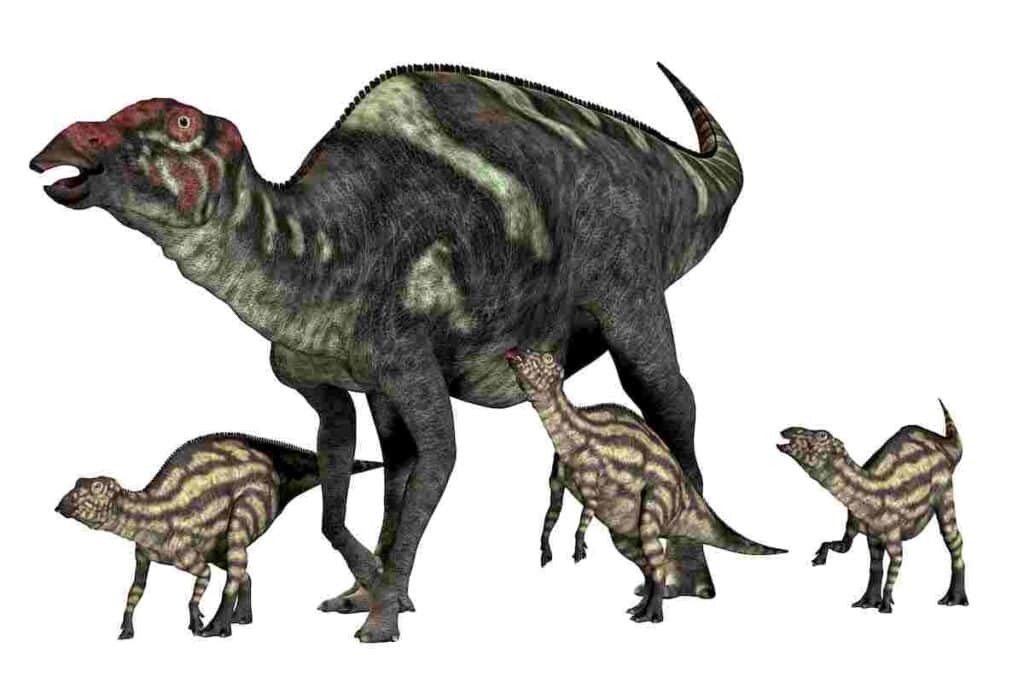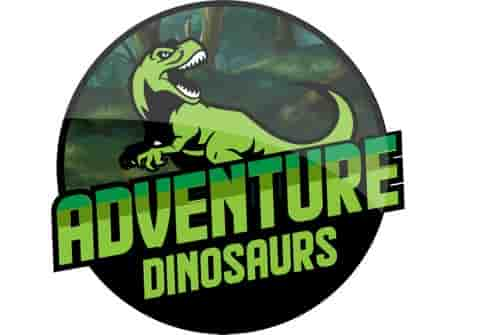The hadrosaur is arguably one of the most interesting dinosaurs. Its fossils have been found worldwide and are famous for different head crests and nesting grounds with dinosaur eggs arranged in the same way they were laid millions of years ago. With their large body, powerful limbs, and duck-bill mouth, these grazing type dinosaurs seem an ideal fit for life in packs – and has been hypothesized by paleontologists to have lived in herds. But which factors influenced why scientists think the hadrosaurs were social and lived in herds?
The evidence that hadrosaurs lived in herds is compelling. Many skeletal fossils of the same hadrosaur species have been found together in the same site. Some hadrosaurs have crests that may have been used for communication. Additionally, scientists have found hadrosaur nesting grounds that indicate they took care of their young. These findings suggest herd living was a part of their lifestyle, and it’s possible they were social creatures too.
Scientists for years have suggested sauropod herd behavior. Similar evidence for hadrosaurs is growing.
Sauropods have been said to have lived in colonies or communities. The social behavior might be because of the need for mutual protection and cooperation among the juveniles, which are small and vulnerable while still growing. When herd members are grown, they can protect the smaller juveniles from predators.
When it comes to hadrosaurs and social behavior, paleontologists have found evidence that these dinosaurs behaved in a gregarious manner as well. Scientists have used the term “herding” to describe some species because of the large number found in close association with one another.
Paleontologists have also found evidence that some hadrosaurs formed “social groups” in which several females would lay their eggs in the same area and share the task of protecting and raising their young. These dinosaur nest sites suggest evidence for social behavior among hadrosaurs.
Let’s delve deeper into this subject!
What Was the Evidence That Hadrosaurs Lived in Herds with Social Behavior?
Dinosaur footprints around fossil deposit sites indicate that duck-billed dinosaurs lived in herds with social behaviors. Paleontologists study fossilized skeletons and footprints of hadrosaurs, and they can tell the dinosaur lived socially.
Hadrosaurs were significantly common during the Cretaceous period, and they left abundant clues about their ancient lifestyles.

When dinosaurs made the footprints about 70 million years ago, they were walking on floodplains. Geological factors turned the muddy plains into rocky mountainsides. Consequently, tracks and skeletal bones got fossilized.
Archeologists also discovered fossils of this species in large numbers at different sites. For example, scientists concluded social behavior and adult protection when excavating over 10,000 hadrosaur skeletons from one site.
For starters, paleontologists could tell the number of years it took juvenile hadrosaurs took to reach maturity. They studied bone ends and arches of the fossils, and they fused by 12 years of age.
Scientists also took a keen interest in numerous fossilized footprints on the mountainsides of Central Alaska. Texan paleontologist, Fiorillo, discovered thousands of dinosaurian footprints with the Denali National Park.
Measuring the size of the dinosaur footprints is another way to prove hadrosaurs lived in mixed-age herds.
The bigger tracks stretched 25 inches across, while the smaller ones spread over three inches. The biggest tracks belonged to adults, especially males. Juveniles made the smallest tracks.
Thus, they could tell apart adult dinosaurs from juveniles within collections of fossils. Approximately 84% of the tracks were adult-sized. Juveniles were always among the minority. (Source)
The fossilized tracks also suggest that these giant sauropods did not migrate over long distances. Instead, they likely moved around the Arctic all year long.
We can also tell these sauropods had social behavior by analyzing fossilized nesting sites. Research suggests that these dinosaurs socially and collectively established nests where they slept and lay eggs. (Source)
Why Did Hadrosaurs Live Herds?
Fossils and nesting sites in the Montana dinosaur deposits suggest parents protected their offspring.
Hadrosaurs lived in herds for survival reasons. The adults stayed together because it helped them dominate herbivorous niches as they came into direct competition with carnivores and plant-eaters.
Some of the competing herbivores were quite brutal, including:
- Scolosaurus
- Cerasinops
- Gryposaurus
Competition determined if they got the best access to the rare flowering plants. They were used to gymnosperms and ferns.
But herbivores were the least of problems for a duck-billed dinosaur. Carnivorous dinosaurs loved feasting on lone, juvenile, or sickly hadrosaurs.
Small-sized hadrosaurs stood no chance against a pack of 6.5-foot Troodons or a single 30-foot Daspletosaurus.
Even smaller predatory dinosaurs could take down adult duck-billed dinosaurs by using packs to isolate lone individuals.
The dominant male hadrosaurs grew over a minimum of 30 feet in length. They could also stand 19 feet tall.
Thus, it was only logical for the biggest adults to protect their offspring. Otherwise, the genus wouldn’t survive over the generations. Predators would have killed all the juveniles. (Source)
Hadrosaurs moved in protective herd formations. The vulnerable dinosaurs stayed at the center of the group. The domineering adults intimidated or harmed predators, preventing them from accessing the young or sickly.
As these sauropods aged, they became less dependent on herd protection.
Egg Mountain is a popular part of Montana. Scientists classify it as an extension of the Two Medicine Formation. The fossil-rich area interested paleontologists in 1977, and they’ve discovered 14 dinosaur nesting sites in the area.
Egg Mountain is famous for alluding to parental care among dinosaurs. They even named the nests Maiasaura peeblesorum, which means ‘caring mother lizard.’ The site contained fossils of eggs, pre-juvenile, juvenile, and adult hadrosaurs that could have socialized within a herd.
Studies also suggest that hadrosaurs moved seasonally. The adults always returned to their hatching place to lay eggs and breed the next generation. They also waited for juveniles to go through a growth spurt and gain the ability to keep up with the herd.
Then, seasonal migrations would continue around the Arctic region. They moved to the coastal plains for feeding, but they retreated to higher altitudes to lay eggs.
How Did Dinosaurs Behave?
Dinosaurs behaved socially if their species required teamwork for survival. For example, predators formed hunting packs to overwhelm gigantic prey.
In contrast, herbivores maintained herds to fend off lone predators.
Dinosaurs also developed physical traits to boost their social status. For example, some hadrosaurs developed head crests for communication and attracting mating partners.
Dinosaurian species communicated via hoots, hollers, dance, song, and cracking sounds. Hadrosaurs, in specific, acquired elaborate crests. (Source)
Fossils reveal the crests performed as resonant extensions of the titan’s breathing mechanisms. Further studies revealed the crest could produce low-frequency sounds.
Hadrosaurs like Parasaurolophus could have used their crests to make music. Are you familiar with seductive ways of trumpets, saxophones, and flutes?
These dinosaurs could have been the best musicians that earth ever hosted.
It’s easy to assume the crests were elaborate language mechanisms for hadrosaurs. ‘The caring mother lizard’ maintained an organized, parental community.
Low-frequency crests and low-frequency ears empowered these dinosaurs to communicate over long distances and through dense vegetation.
Close your eyes and imagine the typical elephant herd in African jungles. They have an elephant language sustained by the low-frequency sound capabilities of their trunks.
They communicate by singing beautiful songs, and philosophers think elephants have souls.
Elephants toil to further the welfare of their calves. They help them over rivers and cliffs. They also form protective circles for the vulnerable, and the bulls fend off lions and hyenas. The social ties are strong, and they even practice ex-communication.
Conclusion
As discussed, paleontologists have been able to deduce that hadrosaurs lived in herds because of the evidence they’ve found — the multiple sites where numerous fossilized remains of the same hadrosaur were found, plus the nesting grounds.
I’ve noticed from the research and publications I’ve read that they are still testing the crests of hadrosaurus that may have served as communication devices or visual signals for other herd members. Let’s hope future discoveries of hadrosaur fossils will get us closer to confirming some exciting social behavior theories.
